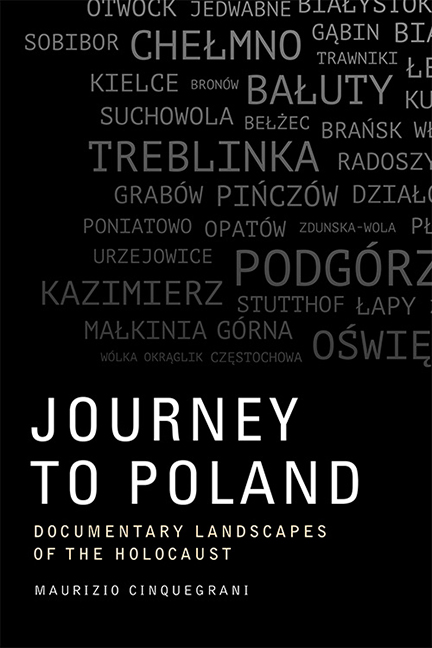Book contents
- Frontmatter
- Contents
- List of Figures
- Acknowledgements
- Dedication
- Prologue: Space, Time and the Holocaust
- 1 Countryside, Shtetl, City: The Murders of Mazovia, Jedwabne and Kielce
- 2 Conflicting Memories in the Shtetlekh Gąbin, Suchowola, Brańsk and Luboml
- 3 The Marketplaces of Postmemory in the Shtetlekh Eishyshok, Delatyn, Opatów, Zdunska Wola, Urzejowice and Pińczów
- 4 A Tale of Two Cities: Warsaw and Kraków
- 5 Another Tale of Two Cities: Lviv and Łódź
- 6 A Tale of Two Cities of Death: Treblinka and Oświęcim
- Epilogue: New Routes
- Bibliography
- Filmography
- Index
2 - Conflicting Memories in the Shtetlekh Gąbin, Suchowola, Brańsk and Luboml
Published online by Cambridge University Press: 10 November 2020
- Frontmatter
- Contents
- List of Figures
- Acknowledgements
- Dedication
- Prologue: Space, Time and the Holocaust
- 1 Countryside, Shtetl, City: The Murders of Mazovia, Jedwabne and Kielce
- 2 Conflicting Memories in the Shtetlekh Gąbin, Suchowola, Brańsk and Luboml
- 3 The Marketplaces of Postmemory in the Shtetlekh Eishyshok, Delatyn, Opatów, Zdunska Wola, Urzejowice and Pińczów
- 4 A Tale of Two Cities: Warsaw and Kraków
- 5 Another Tale of Two Cities: Lviv and Łódź
- 6 A Tale of Two Cities of Death: Treblinka and Oświęcim
- Epilogue: New Routes
- Bibliography
- Filmography
- Index
Summary
‘This is the market. This is where my grandmother sold soap in the market.’
— Jack Rubin, ShtetlIn his work focusing on Polish–Jewish relationships, Holocaust historian Raul Hilberg has explained that ‘in the prevailing Polish view, the Jews could not, despite their protestation of loyalty to the Polish state, share the spirit and longings of the Polish people’ (1993: 204). During the war, this particular perspective resulted in a country divided between those who saw the deportation of the Jews as wish fulfilment and those who sensed that the Jews had to be helped. This ambiguity emerges in Holocaust documentaries that address issues of memory and loss in relation to the void left by the murdered Jews in the cultural and physical landscape of post-war Poland. The present chapter investigates the locations of five films where the testimonies given by survivors and those provided by Poles who spent the rest of their lives in the former shtetlekh are juxtaposed and articulated in connection to the impact of the past on present-day spaces. In Shoah, Claude Lanzmann visits Grabów nad Prosną, a former shtetl situated sixty miles south of the killing centre in Chełmno nad Nerem, and interviews local men and women who remember the Jews of Grabów and their deportation to the camp. What emerges from the filmmaker's discussion with Poles who now live in the houses left vacant by the murdered Jews is a display of anti-Semitism, ignorance and at times genuine sorrow for what happened to their neighbours during the war. This ambivalence has also characterised the more recent cinematic investigations of former shtetlekh which will be discussed in this chapter. A largely reconciliatory image of the Polish–Jewish relationship emerges from Jolanty Dylewskiej's Po-lin. Okruchy pamięci (Po-lin. Slivers of Memory, 2008). This documentary is based on an interplay between past and present images in a number of old shtetlekh, and is partly set in the town of Gąbin, which is also the location of Minna Packer's Back to Gombin (2002). As we shall see, Packer's film presents a more conflicted portrayal of the life shared by Jews and Poles in this shtetl before the war.
- Type
- Chapter
- Information
- Journey to PolandDocumentary Landscapes of the Holocaust, pp. 39 - 58Publisher: Edinburgh University PressPrint publication year: 2018



